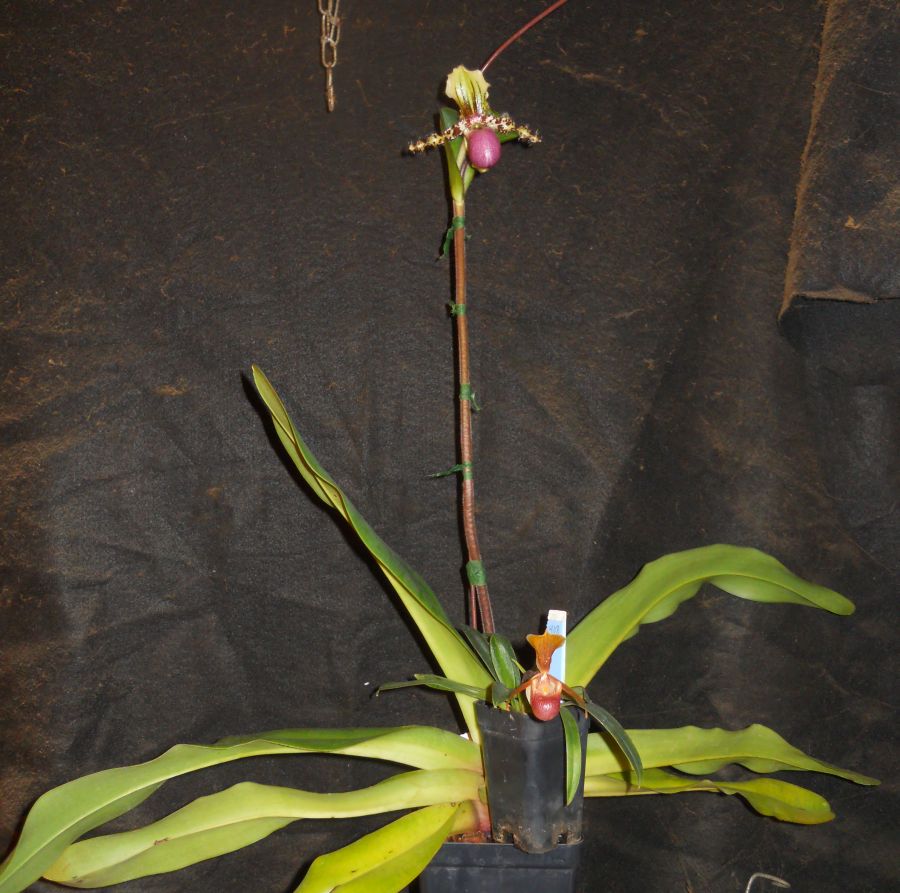Thanks a lot for the info and a photo, Leo.
So after 20 years, it's still a single fan??
But oh boy, isn't that thing big?!!
I hope mine stays small.
I've read that these sequential are warm growers that prefer lots of humidity.
I was thinking if it's too dry here, I'm sure it definitely is.
My chaimberlainiamum tends to stay a one or two growth plant. BUT it also tends to keep blooming on a flower stem for 20 to 30 flowers before the stem browns and dries out. This number of flowers means it stays in bloom for 4 or 5 years on a single inflorescence. While they are blooming they tend to be slow to make new growths. If you want a multi-growth clump, you may have to cut of the flower stem after one or two flowers, to force the plant to put energy into vegetative growth. Mine stayed small until something changed in my culture, and it got "happy". I think the Fertilizer was one key, and the slight increase in humidity and temperature was the other key. It did bloom in a 3 inch pot, and even did the 20 to 30 flower lifespan of the inflorescence. But as Rick said, it was a boom and bust cycle. Plant would do well, then decline, then pick up again. Right now its "Up". Definitely like humidity above 50%, and don't want a chill below maybe 60 F.
I just had a quick check, and my liemianum has heavy markings with strong hairs along the edge of the undulating leaves.
Then you likely have the "real deal", this is good.
My victoria-reginae (the tag says so,so what's the difference then with chamberlainianum?) has very very fine, almost like misted or dusted in appearance of purple spots. Overall, they look green on the underside.
No hairs, very slight undulation along the edge.
I don't know what to think of the fine purple spots, I don't know it they indicate hybrid origin, or if it is just one of the variations possible. I have seen "good" chamberlainianum with mottled leaves, and with plain leaves like mine. I am not a taxonomist, my opinion is just that, though it is based in part on dinner and beer with Guido Braem, he did look at my chamberlainianum when he was here. So I go with his opinion.
If I understood him correctly, Guido's opinion, there are no "victoria-regina" in cultivation, nobody knows for sure what that "species" looks like, there is no type specimen, the original description is vague to the point of being unintelligible, and therefore the name should be discarded. There is a clear description of chamberlainianum, the description agrees well with plants in cultivation under the names of both chamberlainianum and victoria-regina, and the publication of chamberlainianum pre-dates the description of victoria-regina. All victoria-regina in cultivation fit the original description of chamberlainianum. But like the philippinense-laevegatum-roebellinianum debate - we are hobby growers and often the "hobby" refuses to go along with the taxonomists, the hobby sticking to old, or incorrect names even after being presented with the current taxonomic information. I still have a hard time with getting it straight on what to call all those formerly Laelia species that I love. Is it Laelia tenenbrosa? Sophronitis tenebrosa? or Cattleya tenebrosa? So if you want to keep your label as victoria-regina, that is fine, most of us know which species you mean.
Interesting note on accidental mix of the two species, but very much understandable.
A member, Trither, has recently posted two examples of chamberlainianum he has, and one of them looks very much like liemianum at a first glance, but the dorsal is clearly different.
Then again, I've seen some variation among liemianum and far more crazy variations in chamberlainianum.
I see liemianum far more common than chamberlainianum.
Is that because chamberlainianum is more difficult to maintain in cultivation?
I'd love a nice one with dark markings on the dorsal.
Whether a plant is common in cultivation is due to how often breeders made seed pods, nothing to do with how common or rare they are in the wild. I think liemianum is a little bit easier, or more forgiving to grow in the hobby. Also it is a less robust plant, taking less space, has better, less crowded spacing for its flowers, which is a trait hybridizers are concerned with, so I think breeders have made more seed pods of liemianum. Plants come and go in popularity, right now there are very few offering chamberlainianum even under the victoria-regina name. Everyone has primulinum for sale, in all its color forms. Maybe I should hang a seed pod on my chamberlainianum? Next flower, maybe.
I've seen Trithor's photos and he has some interesting plants. He is in South Africa, and he knows the provenance issues with unintentional hybrids being passed off as species. I think he has made his "best guesses" and from photos I don't think I could disagree with his labeling. Without collection location data, it is guess work to make claims about any one plant being "the real deal". But you have my "best guesses" for your plants.
I'm just glad you didn't ask me about glaucophyllum - that is the species that has the most hybrids being passed off as the "faux species". It also is the species that seems to have the greatest natural variation. Especially if you include moquettianum as a variant of glaucophyllum. I am not up to speed on this one. I keep my glaucophyllums separate from my moquettianums, but I don't know what the current view is. They do have different growth habits and flowers, but intergrades seem to exist, which really muddies the waters.
Hope this helps. - Leo





